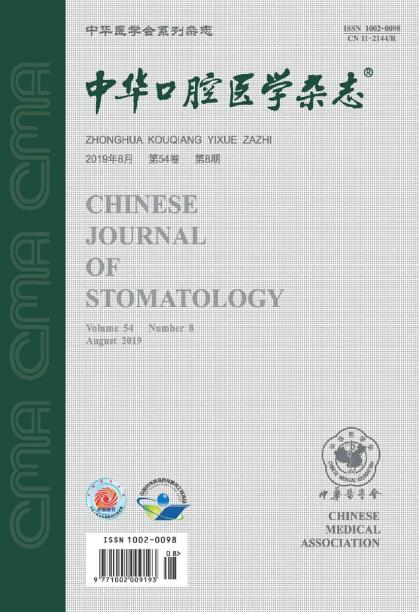[口腔黏膜癌变过程中普雷沃氏菌在组织内浸润的研究]。
摘要
目的:探讨口腔黏膜癌变过程中组织内细菌群落的差异,分析高丰度的中普氏菌(Prevotella intermedium, Pi)与口腔黏膜癌变发生发展的关系。方法:选取南京市口腔医院2022年1月至2024年11月诊断为口腔白斑(OLK)、口腔鳞状细胞癌(OSCC)和健康对照(HC)患者的新鲜组织样本,严格按照纳入标准。从这些标本中提取细菌DNA,利用微生物组2bRAD测序(2bRAD- m)分析和比较组织内细菌的α和β多样性以及群落组成,旨在鉴定特异性表达的细菌。随后采集石蜡包埋临床标本:OLK组15例(单纯性增生4例,轻度发育不良6例,中重度发育不良5例),OSCC组12例,HC组5例。建立了4-硝基喹啉n-氧化物(4NQO)诱导的小鼠OLK进展模型。使用随机数字表将小鼠随机分为三组,每组6只。阴性对照组给予蒸馏水饮用;第1组饮用含4NQO的蒸馏水至第12周,第2组饮用含4NQO的蒸馏水至第22周。小鼠被处死后,收集并固定其舌组织。采用荧光原位杂交技术(FISH)与特异性探针验证了Pi在人和小鼠组织切片中的存在,分析了Pi的组织病理学分级与浸润深度的相关性。结果:2bRAD-M微生物分析显示,Pi在OSCC组织中的相对丰度(10.80%)显著高于HC组(0.50%)(P=0.001)和OLK组(0.70%)(P=0.002)。FISH探针检测显示,人OSCC组织中Pi的荧光强度(125.00±25.13)高于HC组(11.40±25.49)、单纯增生OLK组(11.75±23.50)、轻度发育不良OLK组(26.83±29.51),差异均有统计学意义(P=0.002、P=0.003、P=0.005)。但与中重度发育不良的OLK相比,差异无统计学意义(47.40±26.88)(P=0.210)。人OSCC组织Pi荧光面积(9 255.00±2 048.00)明显大于HC组(18.00±40.25)、单纯增生OLK组(27.00±54.00)、轻度发育不良组(76.00±95.19)、中重度发育不良组(1 628.00±1 265.00),差异有高度统计学意义(P0.001)。Pi的侵袭深度与组织病理学分级程度有显著相关性(P0.001)。小鼠OSCC组织中Pi的荧光强度(119.00±8.54)显著高于HC组(8.17±20.00)(P0.01),与OLK组(34.33±28.28)无显著差异(P < 0.05)。小鼠OSCC组织Pi荧光面积(9 971.0±2 807.0)明显大于HC组(37.83±92.67)和OLK组(451.6±780.1)(P=0.006, P=0.043)。Pi的浸润深度与组织病理学分级程度之间存在显著相关性(P0.001)。结论:本研究提示口腔黏膜组织中Pi可能是早期发现OSCC的潜在生物标志物,在口腔黏膜癌变过程中发挥重要作用。Objective: To explore the differences in bacterial communities within tissues during the process of oral mucosal carcinogenesis, and analyze the relationship between the high-abundance species Prevotella intermedia (Pi) and the occurrence and development of oral mucosal carcinogenesis. Methods: Fresh tissue samples were collected from patients diagnosed with oral leukoplakia (OLK), oral squamous cell carcinoma (OSCC), and healthy controls (HC) at Nanjing Stomatological Hospital, Affiliated Hospital of Medical School, Nanjing University, from January 2022 to November 2024, following strict inclusion criteria. Bacterial DNA was extracted from these specimens, and the 2bRAD sequencing for microbiome (2bRAD-M) was employed to analyze and compare the α and β diversity, as well as the community composition of bacteria within tissues, aiming to identify specifically expressed bacteria. Subsequently, paraffin-embedded clinical specimens were collected: 15 cases in the OLK group (including 4 cases of simple hyperplasia, 6 cases of mild dysplasia, and 5 cases of moderate to severe dysplasia), 12 cases in the OSCC group, and 5 cases in the HC group. A 4-nitroquinoline N-oxide (4NQO)-induced OLK progression mouse model was also constructed. Mice were randomly divided into three groups using a random number table, with six in each group. The negative control group was given distilled water to drink; Group 1 was given distilled water containing 4NQO to drink until week 12, while Group 2 was given distilled water containing 4NQO to drink until week 22. After the mice were sacrificed, their tongue tissue were collected and fixed. Fluorescence in situ hybridization (FISH) with specific probes was used to validate the presence of Pi in human and mouse tissue sections, analyzing the correlation between histopathological grading and the invasion depth of Pi. Results: The 2bRAD-M microbial analysis revealed that the relative abundance of Pi in OSCC tissues (10.80%) was significantly higher than in the HC group (0.50%) (P=0.001) and OLK group (0.70%) (P=0.002). FISH probe detection showed that the fluorescence intensity of Pi in human OSCC tissues [123.50 (101.00, 142.30)] was higher than in the HC group [0.00 (0.00, 28.50)], simple hyperplasia OLK [0.00 (0.00, 35.25)], and mild dysplasia OLK [24.50 (0.00, 55.50)] groups, with statistically significant differences respectively (P=0.002, P=0.003, P=0.005). However, there was no significant difference compared to moderate to severe dysplasia OLK [56.00 (28.00, 62.50)] (P=0.210). The fluorescence area of Pi in human OSCC tissues [8 615.00 (7 439.00, 11 084.00)] was significantly larger than in the HC group [0.00 (0. 00, 45.00)], simple hyperplasia OLK group [0.00 (0.00, 81.00)], mild dysplasia [49.00 (0.00, 151.00)], and moderate to severe dysplasia groups [1 450.00 (454.00, 2 892.00)], with highly significant differences (P<0.001). There was a significant correlation between the invasive depth of Pi and the degree of histopathological grading (P<0.001). In mice, the fluorescence intensity of Pi in OSCC tissues [120.00 (110.00, 127.00)] was significantly higher than in the HC group [0.00 (0.00, 12.25)] (P<0.01), but showed no significant difference compared with the OLK group [50.00 (0.00, 58.00)] (P>0.05). The fluorescence area of Pi in mice OSCC tissues [11 020.00 (6 790.00, 12 102.00)] was significantly larger than in the HC group [0.00 (0.00, 56.75)] and the OLK group [0.00 (0.00, 751.50)] (P=0.006, P=0.043). There is a significant correlation between the depth of invasion of Pi and the degree of histopathological grading (P<0.01). Conclusions: This study suggests that Pi in oral mucosal tissue may be a potential biomarker for early detection of OSCC and play an important role in the carcinogenesis process of oral mucosa.

 求助内容:
求助内容: 应助结果提醒方式:
应助结果提醒方式:


